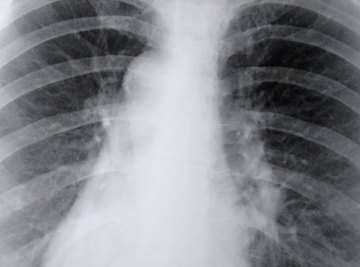
The respiratory system transports oxygen through the blood to all the major organs in the human body. Through breathing, the lungs pull oxygen into the body and expel carbon dioxide. Red blood cells transport oxygen to all the cells around the body.
Oxygen is essential for cell growth and reproduction. Humans breathe about 20 times a minute and much more during physical exertion.
Respiratory system activities and respiratory system games (high school, middle school, and college based) make these complex systems easier to understand.
Physical Demonstration
Students are assigned one of three roles -- lungs, oxygen and carbon dioxide. Children assigned to be the lungs hold hands to form two circles with an opening at the top. As the lungs inhale, children step out to widen the circle. Simultaneously, the students representing oxygen enter the lungs through the opening at the top, then pass into the bloodstream under the joined hands in the circle.
As the lungs "exhale," the students representing carbon dioxide enter the circle under the joined hands. The children in the circle step closer together, forcing the carbon dioxide out of the openings at the top of the circles. This physical demonstration helps children understand the breathing process.
Respiratory System Activities to Test Lung Capacity
Students work in pairs to measure lung capacity. Using a balloon and string, each child breathes one breath as hard as they can into the balloon. The other child measures the circumference of the balloon using the string.
The class discusses that the air in the balloon represents the amount of air that used to be in the students' lungs. They discuss the differences in the lung capacity between the students and come up with various hypotheses on why lung capacity varies.
Exercise
In this activity, children observe breathing patterns at rest and after exercise. Students sit quietly for 30 seconds and reflect on their breathing. Students discuss their breathing rate and how they feel.
Then the children get up and do jumping jacks for 30 seconds. Immediately after the jumping jacks, the students reflect on their breathing. Class discussion focuses on whether the children are breathing faster after exercise and why this is (the body needs to take in more oxygen).
To make it a bit more complex for older students, have them take specific measurements and analyze the data. These measurements could include:
- Breaths per minute (at rest and after exercise)
- Pulse
- Number of jumping jacks in 30 seconds
- Lung capacity of each student
- Etc
Have the students craft a hypothesis, choose what data they collect and have them analyze the data via graphs, equations and comparison of data points.
Worksheet Activities
Children learn key words and concepts about the respiratory system through word searches, puzzles and crosswords. Puzzle activities can be created where the children must put the actions associated with breathing in the correct order (for example, inhalation, oxygen enters the lungs, exhalation, carbon dioxide leaves the lungs).
To make the puzzles more durable, put each action on a piece of cardboard and laminate it. Children can also label drawings of the respiratory system, including lungs and red blood cells. You can make your own worksheets and puzzles or obtain them from the Internet.
Respiratory system games, high school level in particular, can get students engaged with the lesson. You can even have the students create their own game, which will get them to truly understand the information and craft a usable activity.
Online Dissection and Lung Models
Lung models help students better visualize the entire respiratory system. Look for an online dissection and/or lung model system that's interactive.
There may even be dissection and respiratory system games (high school based, middle school based, etc) on these online resources that allow students to match parts of the system for points, quiz themselves and more.
References
About the Author
For more than a decade, Tia Benjamin has been writing organizational policies, procedures and management training programs. A C-level executive, she has more than 15 years experience in human resources and management. Benjamin obtained a Bachelor of Science in social psychology from the University of Kent, England, as well as a Master of Business Administration from San Diego State University.
Photo Credits
thorax x-ray of the lungs image by JoLin from Fotolia.com
